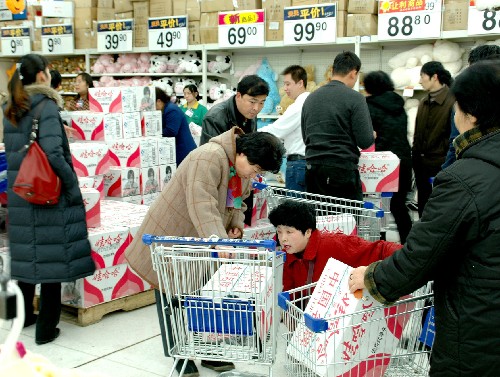
Harbin residents shop for bottled water
yesterday.-Xinhua
An 80-kilometre swathe of polluted water in the Songhua River was
expected to reach the water-sourcing area of the city at about 5 am today,
officials said yesterday in the first detailed explanation for taps running dry.
The worst stretch of contaminated water will pass the capital of
Northeast China's Heilongjiang Province on Saturday morning, an official with
the Provincial Environment Protection Bureau said yesterday.
The State Environment Protection Administration confirmed
yesterday that pollutants containing benzene and nitrobenzene contaminated the
river after a chemical-plant blast at the upper reaches, leaving a trail of dead
fish.
The explosion on November 13 in Jilin city in neighbouring Jilin
Province forced Harbin, a city of 3.8 million which relies largely on the
Songhua for its water and is situated on the middle reaches of the river, to
suspend supply for four days starting on Tuesday midnight.
On November 20, a water-checking station in Zhaoyuan County on the
provincial border found that the level for the two chemicals was much higher
than the State standard, said Li Ping, the Heilongjiang environmental bureau
spokesman.
At one time, the nitrobenzene level was 103.6 times higher than
normal; and the contaminated belt of water still considered dangerous to humans
was flowing at about 2 kilometres per hour, the bureau said.
Zhang Lanying, director of the Environment and Resources Institute
of Jilin University, said that benzene which does not dissolve in water is a
dangerous substance.
People who drink water with a little benzene can have oral
festering. "Massive amounts can lead to the disorder of blood cells; in other
words, leukaemia," she said.
"Harbin's move to cut off the water supply was not a knee-jerk
reaction.
"If the contaminated water had been supplied to households, the
result would have been unimaginable."
To speed up the flow of the river and dilute the contamination,
Jilin city has increased the water discharge volume of Fengman Hydroelectric
Power Plant, said a spokesman.
As for cities and counties downstream of Harbin, 90 per cent rely
on groundwater as the main water source, said Dong Shuhua, director of the
Heilongjiang Water Information Bureau.
"They will not be very much affected."
In Harbin, the panic buying of water and attempts to get out of
the city were not as frantic yesterday as in previous days.
Adding to residents' relief was 15 hours of water supply to parts
of the city and availability of bottled water in shops and supermarkets.
Zhao Wanxia, a saleswoman, said she had stored enough water to
last for a few days. "I first wash vegetables, then use the water to clean the
floor or flush the toilet."
More than 16,000 tons of bottled water was being transported to
Harbin from neighbouring cities including 10 train carriages carrying 1,000 tons
from Shenyang, capital of Northeast China's Liaoning Province.
The city's 918 wells are all in operation and teams from Daqing
Oilfield are drilling another 100 wells, said Wang Zhengbang, deputy secretary
of the Harbin municipal government.
The government has designated 10 hospitals to treat patients in
case they drink contaminated water.
The government has earmarked 10 million yuan (US$1.2 million) to
deal with emergencies; and allocated 1 million yuan (US$120,000) to help the
poor, elderly and those living alone.
Wang urged residents to keep away from the riverbank for fear of
contamination.
Despite the water cut-off, officials have assured residents of
normal operation of the city's heating system.
But they told people yesterday not to take water from the system
for household use.



